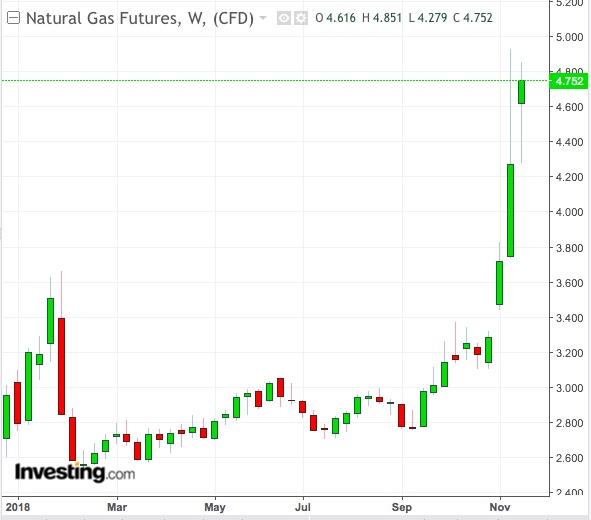The first natural gas draw of this cold season is expected to figure in today’s weekly inventory report due from the US government at noon EST. Aside from marking the unofficial start to winter, there’s usually little fanfare from this event. That said, 2018 has been no ordinary year for natural gas, and this draw could also bring its own drama.
With daily price swings of up to 19 percent, natural gas futures on the New York Mercantile Exchange have returned to their legendary "Wild West" of commodities billing, with bucking-bronco-like gyrations seen through last week.

Now, for the first time in nearly five years, NYMEX’s front-month gas contract, December, could test the key $5 pricing mark as stockpiles of the fuel start getting drawn from underground caverns to meet power demands for heating.
Winter Reserves Lowest In 15 Years
In fact, December gas came in less than 10 cents from hitting that threshold when it rose to $4.929 per million British thermal units (mmBtu) a week ago. With pre-winter gas reserves at their lowest in 15 years, bets are high that $5 per mmBtu will be reachable soon.
But there’s also speculation that once that “magic number” is reached, prices could reverse direction and tumble—unless, of course, there’s sufficiently cold weather and commensurate heating demand.
Dan Myers, natural gas analyst at Gelber & Associates in Houston, said:
“Following this inventory report and the Thanksgiving holiday, the market will be looking to establish a fair price of gas for this winter. But, in the meantime, a test of $5 and a crash back below $4 are both equally within reach.”
'A Lot Of Weight' On Thursday Inventory Report
The US Energy Information Administration is due to release the gas supply-demand report for the week ending November 16 at 12:00 PM ET (1700 GMT).
Myers said “a lot of weight” was being placed on the inventory report after last week’s early blast of cold weather, seen as a test of heating demand for the official winter cycle beginning in exactly a month. He predicts the inaugural draw of the season will be 105 billion cubic feet—about 80 bcf larger than the five-year average pull from storage at this time of year.
Other industry analysts are expecting a consensus draw of 109 bcf draw, said Reuters, which added that it would be the earliest triple digit storage decrease in November on record, according to federal energy data going back to 1994. Reuters also reported that there were 173 heating degree days (HDDs) last week, compared with 129 HDDs in the same week a year ago and a 30-year normal of 110 HDDs for the period.
HDDs measure the number of degrees a day's average temperature is below 65 degrees Fahrenheit (18 degrees Celsius). The measure is used to estimate demand to heat homes and businesses.
Above-Normal Heating Demand Expected
Dominick Chirichella at New York’s Energy Management Institute said:
“The cold temperatures are lingering over the eastern half of the country and over the high natgas demand areas of the country. The call on natgas for heating related demand will be above normal for this time of the year.”
Gas in storage currently stands at 3.25 trillion cubic feet and a withdrawal of 109 bcf would leave inventories at their lowest since 2003, nearly 16 percent below the 5-year average, data showed. Natural gas has also been one of the most-difficult-to-guess commodity markets this year due to its supply-demand peculiarities.
Gas Latest Gains Were At The Expense Of Crude Oil
Huge volumes of gas, sourced from primary drilling but also obtained in secondary form during drilling for shale crude, have led to record output of the fuel—not unlike the situation in crude oil. Despite such overwhelming output, storage levels of gas never reached the danger of tipping, thanks to first strong summer heat and, now, early cold that kept air-conditioners and heaters respectively on overdrive.
But unlike crude oil prices, which initially rallied to four-year highs before being beset by the most prolonged selloff in history, natural gas looks poised to finish as 2018’s best commodity, with a year-to-date gain of 55 percent. Traders also said some of the latest gains for gas have come at the expense of oil, as hedge funds shorted crude while going long gas.
And with another 3-1/2 months left to the cold weather cycle, the path of least resistance seems lower.
